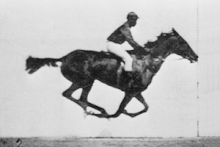Top walkers

Pointed walkers or tip-toe walkers are terrestrial vertebrates that only touch the ground via their anatomical fingertips or toes when moving. This type of locomotion is also called unguligrade gait (from lat. Ungula "hoof", gradi "to walk") or unguligradie , which refers to the fact that all recent top walkers are ungulates (ungulata). The unguligradie in both ungulates and ungulates has developed independently of each other.
features
The unguligradie is realized by the more or less strongly lengthened metapodium (metapodium or metatarsus) including the directly adjoining finger or toe phalanges ( phalanges ) acting as part of the arm or leg and the wrist or ankle joint acting as one second elbow or knee joint, or in other words: all elements of the anatomical hand or the anatomical foot with the exception of the terminal phalanges are the distal elements of the functional arm or functional leg . Associated with this foot structure is a strong reduction in the weight-bearing finger or toe rays: in ruminants (cloven- toed ungulates) to two, in horses (unpaired ungulates) to a single finger or toe ray. Also, the terminal phalanges of the remaining toe beams are connected to a horn cap, the hoof coated.
Animals with an unguligrad gait are usually good and fast runners, not least because the stride length is relatively large due to the lengthening of the functional arm or leg, so that a relatively long distance can be covered with each step. With the pronghorn and the Thomsonian gazelle , among others , the top walkers represent some of the fastest terrestrial vertebrates on earth.
Delimitations
A distinction is made between the top walkers , the toe walkers , who put on the complete acropodium (all finger or toe phalanx), and the sole walkers , who put on the complete autopodium (the entire anatomical hand or the entire anatomical foot).
Among the ungulates, only the ruminants and horses are completely unguligrad. Other pair and odd-toed ungulates, for example pigs , camels and tapirs , are considered to be semi-unguligrad because they do not touch the ground through all of the phalanges, but also not exclusively through the terminal phalanges. Pigs have no “real” hooves, just hoof-like claws, and the soles of their functional feet also have weakly horny pads . In these animals, too, the outer (lateral and medial) fingers or toes are usually less strongly reduced, although they are often no longer functional.
In particularly heavily built herbivorous mammals such as hippos , rhinos and elephants , a special form of foot structure has developed, which is also referred to as semi-unguligrad or sub-unguligrad. These representatives have three to five functional (i.e., weight-bearing) fingers or toes. The lower leg is usually rather stocky, the anatomical foot is columnar, and on the outside fingers or toes are only formed as stumps or not at all. In particular, the more proximal parts of the foot skeleton, together with the muscles and ligaments, rest on a thick pad made of elastic connective tissue, through which they are in contact with the functional sole of the foot. The body weight therefore rests not only on the distal phalanges of the fingers or toes, but also, depending on the structure of the hand or foot, on the proximal phalanges, the metapodium or even the entire autopodium. Strictly speaking, this is a special form of digitigrady, semi-planigrady or planigrady. Because he is a modification in the course of a general significant, sometimes extreme increase in body size and body weight, this Fußbau will graviportal called. It already appeared convergent in the large, long-necked, herbivorous dinosaurs ( sauropods ). Hippos (arthropods), rhinos (unpaired ungulates), and elephants (elephants) are each graviportal independently of one another.
literature
- Christopher McGowan: The Raptor and the Lamb - Predators and Prey in the Living World. Penguin Books, London 1998, ISBN 0-14-027264-X
- P. David Polly: Limbs in mammalian evolution. Pp. 245-268 in: Brian K. Hall (Ed.): Fins into Limbs: Evolution, Development, and Transformation. University of Chicago Press, Chicago 2007, ISBN 978-0-226-31336-8
- Wilfried Westheide, Reinhard Rieger (Hrsg.): Special zoology. Part 2: vertebrates or skulls. 2nd Edition. Spectrum Academic Publishing House, Berlin / Heidelberg 2010, ISBN 978-3-8274-2039-8
Individual evidence
- ^ A b C. E. Miller, C. Basu, G. Fritsch, T. Hildebrandt, JR Hutchinson: Ontogenetic scaling of foot musculoskeletal anatomy in elephants. Journal of the Royal Society Interface. Vol. 5, No. 21, 2008, pp. 465–475, doi : 10.1098 / rsif.2007.1220 ( Open Access )
- ↑ GE Weissengruber, GF Egger, JR Hutchinson, HB Groenewald, L. Elsässer, D. Famini, G. Forstenpointner: The structure of the cushions in the feet of African elephants ( Loxodonta africana ). Journal of Anatomy. Vol. 209, No. 6, 2006, pp. 781–792, doi : 10.1111 / j.1469-7580.2006.00648.x ( Open Access )
- ↑ Oliver M. Rauhut, Regina Fechner, Kristian Remes, Katrin Reis: How to Get Big in the Mesozoic: The Evolution of the Sauropodomorph Body Plan. Pp. 119-149 in Nicole Klein (Ed.): Biology of the Sauropod Dinosaurs: Understanding the Life of Giants. Indiana University Press, Bloomington (IN) 2011, ISBN 978-0-253-35508-9 , pp. 133 ff.
